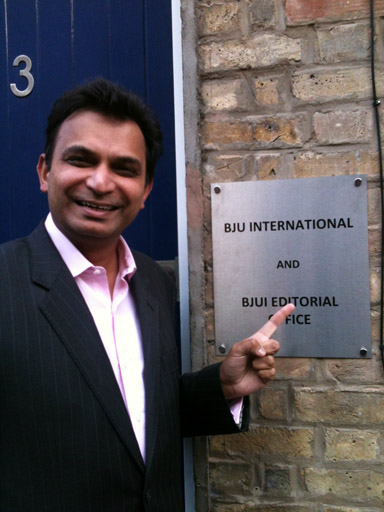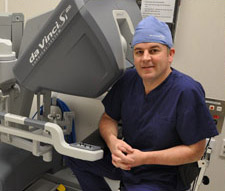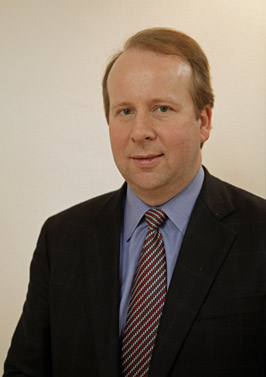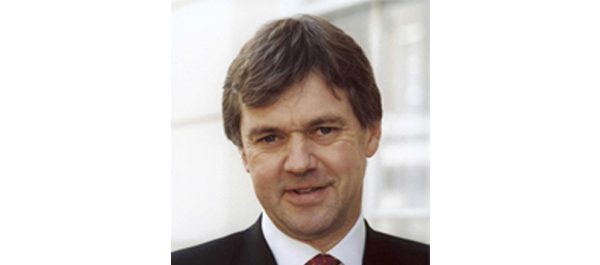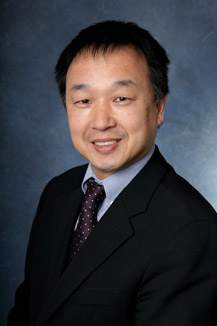 International Urology Journal Club on Twitter: The Beginnings of a New Application of Social Media in Urology CME
International Urology Journal Club on Twitter: The Beginnings of a New Application of Social Media in Urology CME
The International Urology Journal Club on Twitter almost came about by accident, although the formation of such was an inevitability. Over the course of 2012, a number of research papers have been the subjects of discussion amongst urologists on Twitter.
The standout paper as example for discussion in 2012 was the PIVOT study. This generated comments that were difficult to follow unless you were following all of the many participants. Although one could find the majority of the tweets in chronological order by doing a search under the tab “Discover”, it was still dependent upon whether the term PIVOT was used in the tweet or not – it was quite often the case that a comment was made without the term PIVOT being used and these would be missed by a search for PIVOT. In essence, a form of journal club was already happening although there was no organized manner by which all comments could be filed or arranged to provide context. When limited to 140 characters, a tweet can easily lose context if it cannot be connected to other tweets it may refer to or be in reply to. The use of a hashtag provides a filing system for related tweets and had all participants in the PIVOT study discussion used the hashtag #PIVOT, a search under that term would have enabled easy following and review of the discussion pertaining to that topic. The use of a hashtag does require general agreement by contributors that this will be the agreed filing (this is what I call it even though it is not a universal way of describing it) system for the tweets. It also meant that inclusion of long twitter handle names such as @cooperberg_ucsf would not eat into the precious 140 character limit to which we wish to make comment – as we are a tolerant, respectful and good humoured community, we of course continue to tolerate this blight on our character count. (I have incidentally shortened my Twitter name from @DrHenryWoo to @DrHWoo as a donation of 4 precious characters to those who wish to engage me on Twitter).
So how did the International Urology Journal Club on Twitter come about? It all started with Canadian urologist Michael Leveridge sending a few live tweets from his local journal club and nominally used the hastag #quroljc, which stood for Queens Urology Journal Club. A number of urology colleagues around the world, including myself, were intrigued by this.
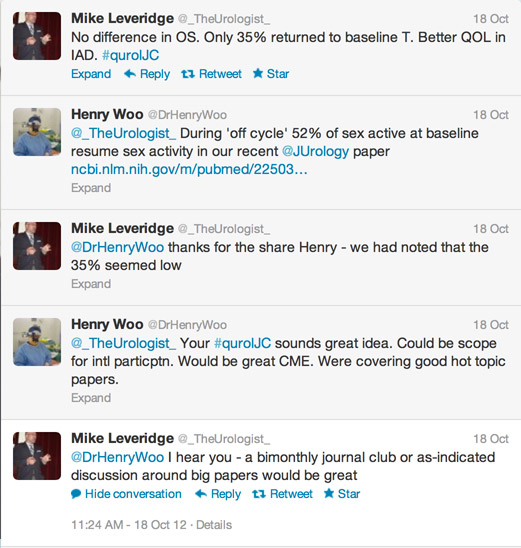
Following an exchange of tweets, we came to realization that we were effectively engaging in a Twitter urology journal club. We soon realized that in order to do this effectively, we needed a hashtag to which we could all tweet our journal club responses and the hastag #urojc was born.

According to the exchange of tweets above, we can credit Michael Leveridge for coining the hashtag #urojc. On Twitter, it does not take long for the message to spread.
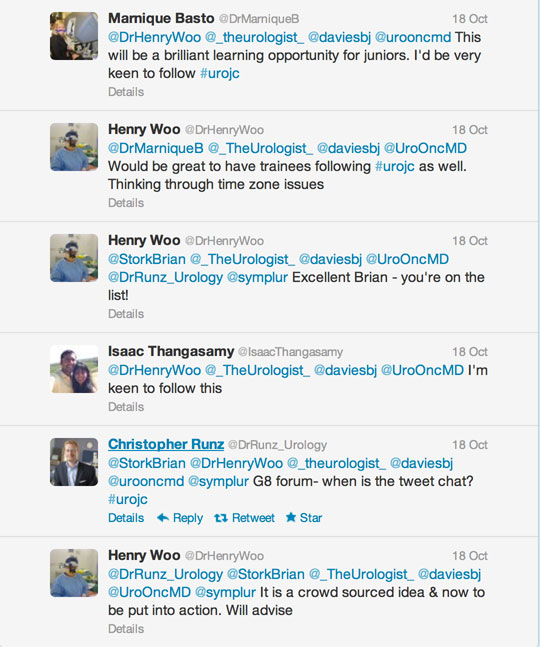
To administer Journal Club, an administrative account @iurojc and specific blog account was established. You will note that the administrative account is @iurojc and not @urojc since the latter had already been taken by another urologist. The #urojc blog carries information about the journal club as well as the tweet logs from the discussions.
In short, a recently published manuscript is selected for each month’s discussion. Such manuscripts are usually those that have been published online ahead of print in order to offer the most cutting edge research discussion. Discussions occur on the first Sunday or Monday of each month depending on which time zone you are in. Tweet discussion is carried out in an asynchronous manner over the course of 48 hours. Since commencing in November 2012, there has been a truly global engagement and with the amplification effect of Social Media, we have seen in excess of 50,000 impressions (a Twitter metric of reach). A novel approach to this format of journal club is the invitation and participation of the lead author and/or corresponding author associated with the paper for discussion – there is no question that this significantly enhances the value of the discussion.
Prior to the commencement of the first #urojc discussion, it was suggested that there should be a prize for the best tweet. This has now been instituted and a #urojc Hall of Fame is now in the making. With the Best Tweet prize for November 2012 being awarded to Ben Davies, it has only fueled his belief that he is indeed the urological King of Twitter. He is, however, the inaugural prize winner and at the top of the list of the #urojc Twitter Hall of Fame. The winner of the December Best Tweet Prize was another Ben, namely Ben Jackson. We thank Urology Match and Nature Reviews in Urology for donating the prizes for November and December respectively. Whilst there were suggestions of a Ben conspiracy, we cannot promise that the January Best Tweet Prize, which has been donated by the Urological Society of Australia and New Zealand (USANZ) will be awarded to a non-Ben participant.
It is our belief that the #urojc is the first truly international clinical journal club discussion taking place on Twitter in an organized manner. Whilst there are local real time Twitter journal club chats and similar discussions in non-clinical areas of health care, this is again a demonstration of how urologists lead the way with the embracement of technology to advance health care. For now, the discussions are on a monthly basis with a focus on uro-oncology. As interest grows, the plan is to expand to twice monthly with the mid-month discussion being on topics such as endourology or voiding dysfunction or female urology or any other area of interest. Do follow @iurojc and put forward your suggestions for papers to discuss. Again remember that the Twitter user name is slightly different to the hashtag, which is #urojc.
We look forward to having you join us for the next #urojc.
Henry Woo is an Associate Professor of Surgery at the Sydney Adventist Hospital Clinical School of the University of Sydney in Australia. He has been appointed as the inaugural BJUI CME Editor. He is currently the coordinator of the International Urology Journal Club on Twitter. Follow him on Twitter @DrHWoo
January #urojc paper will be on PHI by @LoebStacy jurology.com/article/S0022-… ncbi.nlm.nih.gov/pubmed/23206426
Comments on this blog are now closed.
 Dirk De Ridder
Dirk De Ridder









